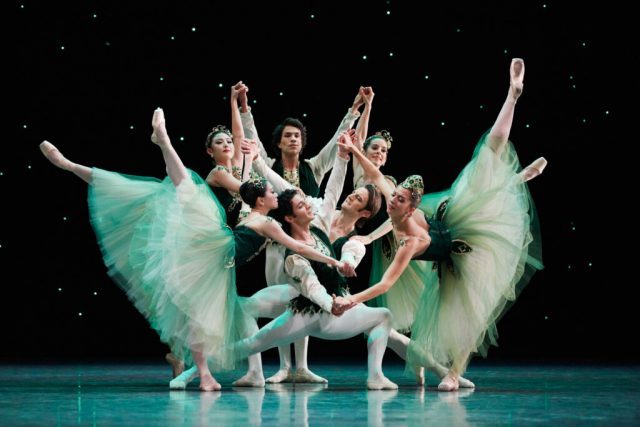
San Francisco Ballet presents a dazzling virtual production of Balanchine’s Emeralds (photo by Erik Tomasson)
JEWELS
SF Ballet online
Available on demand through April 21, $29
www.sfballet.org
You’re likely to let out a gasp when the curtain rises on San Francisco Ballet’s newly filmed production of George Balanchine’s Emeralds, the first section of the legendary choreographer’s three-part masterpiece, Jewels. I know I did. Onstage are a dozen dancers, the most I’ve seen at any one time together since the pandemic lockdown started. Then Gabriel Fauré’s score kicks in — consisting of extracts from Pelléas et Mélisande Suite, Op. 29 and incidental music to Shylock, Op. 57, conducted by Martin West — and principals Misa Kuranaga and Angelo Greco touch hands, leading to another gasp. I’ve watched a lot of dance pieces made during the current health crisis, but it’s mostly been solos or works outdoors, with no contact between performers. To see a full ensemble dance without restrictions for thirty glorious minutes is exhilarating, especially every lift, throw, and turn involving physical human connection. (Of course, SFB followed all Covid-19 protocols.)
The floor of the War Memorial Opera House reflects the dancers, who are wearing dark tops with necklaces, the women in green calf-length tulle skirts. A chandelier laden with faux emeralds hangs above, while stars dot the back wall, melding inside and outside. Balanchine considered Emeralds to be “an evocation of France — the France of elegance, comfort, dress, and perfume,” and that’s precisely what comes across in this glittering production, staged by the late Elyse Borne and Sandra Jennings, with additional decor by Susan Touhy and costumes by Karinska (re-created by Haydee Morales).
The camera slowly zooms in and out and pans right and left but always stays at orchestra level while concentrating on two couples, a trio, and a corps de ballet of ten women. The many stunning moments include a line of four women in attitude position, with three men on their knees, their right leg flat behind them, all holding hands; a gorgeous solo by Kuranaga; duets first with Kuranaga and Greco, then with Sasha Mukhamedov and Aaron Robison; and a concluding trio with Greco, Robison, and Esteban Hernandez, the three men left all alone at the end, their arms reaching out dramatically.
As the curtain descends, something strange and unexpected happens; applause can be heard, getting louder as the dancers take their bows. The work was filmed on January 28 without an audience, and there was no piped-in applause at intermediary points of beauty. It’s a bit unnerving, since we know that the seats are empty, though the show is well worthy of high praise.
Emeralds debuted at the New York City Ballet on April 13, 1967, followed by Rubies and Diamonds, a sparkling trilogy inspired by Claude Arpels’s designs for jeweler Van Cleef & Arpels. For both of the latter pieces, applause is heard as the curtain rises and throughout; the former was recorded February 2, 2016, the latter March 12, 2017, both at the War Memorial as well, giving the full program an added visual continuity, making it feel as if it is all occurring over the course of one evening. It also might explain why SFB decided not to add more camera angles to the 2021 performance; it would have been exciting to see closeups as well as views from the mezzanine, but it would not have matched the next two works.
The featured trio for Rubies are Mathilde Froustey, Pascal Moulat, and Wanting Zhao; the cast is dressed in tight red bejeweled tops with frills at the waist, the women with red hair accessories. Set to Stravinsky’s Capriccio for Piano and Orchestra, Rubies is passionate and exuberant; in one pas de deux, Froustey, wearing a flowery red tiara, and Moulat run, bounce, and spin around the floor. The focus is on the movement itself; there is no chandelier, and the stars on the backdrop are muted.
An homage to Marius Petipa, Diamonds is an opulent, luxurious climax, taking place in an icy blue world with two chandeliers and Tchaikovsky’s lovely Symphony No. 3 in D major, Op. 29, movements 2, 3, 4 & 5, conducted by Ming Luke. It begins with a glorious seven-minute scene with first twelve, then fourteen women, in glistening white tutus, followed by a pas de deux between De Sola and Tiit Helimets. In the finale, more than thirty dancers come together for a grand ball, intersecting and weaving among themselves with an infectious romanticism as the music builds to a thrilling crescendo.
And then, one last surprise; as the dancers take their bows, audience members rise to give a standing ovation, their heads partially blocking our view. It is an apt reminder that ballet — and theater, music, opera, et al. — is meant to be seen live and in person, in a crowd of people all there for one purpose, to share an experience that is happening right then and there, in real time. May it soon be so again.
(For more on SFB’s Jewels, you can stream a virtual discussion about “three composers, three styles, three moods” with De Sola, Helimets, Mukhamedov, and Molat here; there is also extensive background information available here.)